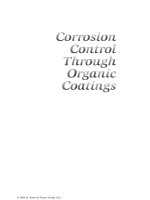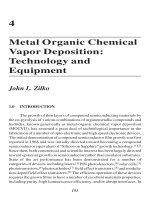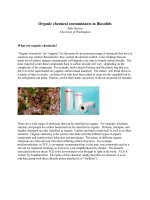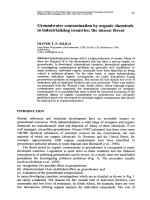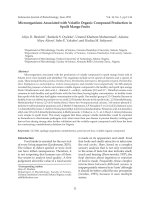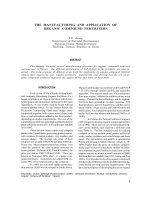CMG GardenNotes #234 Organic Fertilizers docx
Bạn đang xem bản rút gọn của tài liệu. Xem và tải ngay bản đầy đủ của tài liệu tại đây (103.18 KB, 8 trang )
234-1
Colorado Master Gardener
sm
Program
Colorado Gardener Certificate Training
Colorado State University Extension
CMG GardenNotes #234
Organic Fertilizers
Outline: Terms, page 1
Plant by-products, page 2
Alfalfa meal or pellets, page 2
Corn gluten meal, page 3
Cottonseed meal, page 3
Soybean mean, page 3
Animal by-products, page 3
Bat guano – high N, page 3
Bat guano – high P, page 4
Blood meal, page 4
Bone meal, page 4
Feather meal, page 5
Fish emulsion, page 5
Enzymatically digested hydrolyzed liquid fish, page 5
Fish meal, page 5
Fish powder, page 6
Compost, manure and biosolids based products, page 6
Rock powders, page 6
Colloidal phosphate, page 6
Seaweed, page 7
Kelp meal, page 7
Kelp powder, page 7
Liquid kelp, page 7
Terms
By legal definition, the term fertilizer refers to a soil amendment that guarantees
the minimum percentages of nutrients (at least the minimum percentage of
nitrogen, phosphate, and potash).
An organic fertilizer refers to a soil amendment derived from natural sources that
guarantees, at least, the minimum percentages of nitrogen, phosphate, and potash.
Examples include plant and animal by-products, rock powders, seaweed,
inoculants, and conditioners. These are often available at garden centers and
through horticultural supply companies.
These should not be confused with substances approved for use with the USDA
National Organic Program (NOP). The USDA NOP, with its “USDA Organic”
label, allows for the use of only certain substances. The Organic Materials Review
Institute (OMRI at www.omri.org
) approves brand name products made with
ingredients from the “national list” for use with the NOP. (For details refer to
www.ams.usda.gov/nop
and click “NOP Regulations” and then “National List
234-2
Information”). Many of the organic fertilizers listed here will meet NOP standards
(based on the National List). Growers participating in the NOP should consult
with their certifier to ensure compliance for organic certification.
The terms soil amendment refers to any material mixed into
a soil. Mulch refers
to a material placed on the soil surface. By legal definition, soil amendments make
no legal claims about nutrient content or other helpful (or harmful) effects it will
have on the soil and plant growth. In Colorado, the term compost is also
unregulated, and could refer to any soil amendment regardless of active
microorganism activity.
Many gardeners apply organic soil amendments, such as compost or manure,
which most often do not meet the legal requirements as a “fertilizer” but add small
amounts of nutrients.
Notes:
Release Time
– Organic products require the activity of soil microorganisms
before nutrients are available for plant uptake. Microorganism activity is
generally dependant on soil temperatures greater than 50ºF in the presence
of sufficient soil moisture. Dry and/or cold soil conditions will delay the
release of nutrients from these organic sources. This period refers to how
long these products are available if applied to the soil. Use this
information to time the application of the product.
Application
– Different products may be applied in various ways. Some may be
tilled in (worked into the soil with a machine or hand tool), others may be
applied as a foliar spray (mixed with a surfactant and sprayed in a fine mist
on the leaf surface while temperatures are below 80ºF), and some may be
injected into a drip or overhead irrigation system (fertigation with a siphon
mixer). Application rates in this fact sheet are generalized and based on
some manufacturers’ recommendations. Over- or under-fertilization may
occur using these recommendations.
Plant By-)roducts
Alfalfa Meal or Pellets
Alfalfa meal or pellets are often used as animal feed. Primarily they are used to
increase organic matter in the soil but do offer nutrients and a high availability of
trace minerals. They contain trianconatol, a natural fatty-acid growth stimulant.
Alfalfa Meal or Pellets
Typical NPK analysis 2-1-2
Release time 1-4 months
Pros Available at feed stores
Cons May contain seeds
Application Till in 2-5 pounds per 100 square feet
234-3
Corn Gluten Meal
Corn gluten meal materials have a high percentage of nitrogen. It carries a
warning to allow 1 to 4 months of decomposition in the soil prior to seeding.
Allelopathic properties will inhibit the germination of seeds. However, there is no
danger to established or transplanted plants. This product is also marketed as a
pre-emergent weed control for annual grasses in bluegrass lawns.
Corn Gluten Meal
Typical NPK analysis 9-0-0
Release time 1-4 months
Pros Very high nitrogen
Cons Germination inhibitor, some are GMOs
Application Till in 20-40 pounds per 1000 square feet
Cottonseed Meal
Cottonseed meal is a rich source of nitrogen. Buyers should be aware that many
pesticides are applied to cotton crops and residues tend to remain in the seeds.
Pesticide-free cottonseed meal is available.
Cottonseed Meal
Typical NPK analysis 6-0.4-1.5
Release time 1-4 months
Pros High nitrogen
Cons Pesticide residues, most are GMOs
Application Till in 10 pounds per 100 square feet
Soybean Meal
Used primarily as an animal feed product. Available bagged at many feed stores.
Soybean Meal
Typical NPK analysis 7-2-1
Release time 1-4 months
Pros High nitrogen, available at feed stores
Cons Almost half of the conventionally grown soy is
GMO
Application 8 pounds per 100 square feet
Animal By-Products
Bat Guano – High N
Bat guano (feces) harvested from caves is powdered. It can be applied directly to
the soil or made into a tea and applied as a foliar spray or injected into an irrigation
system.
234-4
Bat Guano – High N
Typical NPK analysis 10-3-1
Release time 4+ months
Pros Stimulates soil microbes
Cons Cost
Application Till in 5 pounds per 100 square feet or as a tea at
3 teaspoons per gallon of water
Bat Guano – High P
Bat guano (feces) harvested from caves is powdered. It can be applied directly to
the soil or made into a tea and applied as a foliar spray or injected into an irrigation
system. Difference is that it is processed for high phosphorus content.
Bat Guano – High P
Typical NPK analysis 3-10-1
Release time 4+ months
Pros Stimulates soil microbes
Cons Cost
Application Till in 5 pounds per 100 square feet or as tea at 3
teaspoons per gallon of water
Blood Meal
Blood meal, made from dried slaughterhouse waste, is one of the highest non-
synthetic sources of nitrogen. If over-applied it can burn plants with excessive
ammonia.
Blood Meal
Typical NPK analysis 12-0-0
Release time 1–4 months
Pros Available at feed stores
Cons Can burn. Expensive at garden centers
Application Till in 5–10 pounds per 100 square feet
Bone Meal
A well-known source of phosphorus, bone meal is steam processed and widely
available at feed stores and in garden centers. If purchased at feed stores,
phosphorus is expressed on the label as elemental phosphorus and is 2.3 times
higher than numbers shown on garden center labels for phosphate (i.e. – 12%
phosphate is the same as 27% phosphorus). However, recent CSU research has
shown that phosphorus from bone meal is only available to plants in soils that
have a pH below 7.0.
Bone Meal
Typical NPK analysis 3-15-0
Release time 1–4 months
Pros Highly plant available form of phosphorus
Cons Cost
Application Till in 10 pounds per 100 square feet
234-5
Feather Meal
Sourced from poultry slaughter, feather meal has fairly high nitrogen levels but is
slow to release the nitrogen.
Feather Meal
Typical NPK analysis N varies 7 – 12% on process
Release time 4+ months
Pros Long term fertilizer
Cons Cost versus speed of nitrogen release
Application Till in 2.5-5 pounds per 100 square feet
Fish Emulsion
Infamous for its foul smell, emulsions are soluble, liquid fertilizers that have been
heat and acid processed from fish waste.
Fish Emulsion
Typical NPK analysis 5-2-2
Release time 1 – 4 months
Pros Adds needed micronutrients
Cons Some have foul smell
Application Mix 6 tablespoons per gallon of water
Enzymatically Digested Hydrolyzed Liquid Fish
Enzymatically digested hydrolyzed liquid fish have used enzymes to digest the
nutrients from fish wastes instead of using heat and acids. This retains more of the
proteins, enzymes, vitamins and micronutrients than emulsions.
Enzymatically Digested Hydrolyzed Liquid Fish
Typical NPK analysis 4-2-2
Release time 1 – 4 months
Pros More nutrients than emulsions
Cons More expensive than emulsions
Application Mix 5 tablespoons per gallon of water
Fish Meal
Fish meal is ground and heat dried fish waste.
Fish Meal
Typical NPK analysis 10-6-2
Release time 1 – 4 months
Pros N and P source
Cons Heat processed
Application Till in 5-10 pounds per 100 square feet
234-6
Fish Powder
Fish power is dried with heat and turned into water-soluble powder. It is a high
source of nitrogen. Many can be mixed into solution and injected into an irrigation
system.
Fish Powder
Typical NPK analysis 12-0.25-1
Release time Immediate to 1 month
Pros Adds micro-nutrients
Cons Heat processed
Application Till in 1-2 ounces per 100 square feet OR mix at
1 tablespoon per gallon of water
Compost, Manure, and Biosolid Based Products
For information on biosolids, worm casting, manure, and compost, refer to the
following CMG GardenNotes:
#241, Soil Amendments
#242, Using Manure in the Home Garden
#243, Using Compost in the Home Garden
Rock Powders
Rock powders relevant for use in Colorado soils are those that supply phosphorus.
Those that serve as a potassium source (greensand, feldspar, potassium sulfate,
biotite, etc.) are not necessary as Colorado soils are naturally high in potassium.
Similarly, it is not necessary to add calcium (gypsum, lime, etc.) due to naturally
high calcium levels in Colorado soils and arid conditions.
If you are making annual applications of manure and/or compost to your garden to
add nitrogen, you should have sufficient levels of phosphorus in your soil. If you
are applying manure or compost to your garden based on phosphours needs, you
might have an excess nitrogen supply. Excess nitrogen can lead to poor
flower/fruit development and increases water pollution potential from nitrogen
leaching from the soil.
Generally, plant or animal sources are the best value for phosphorus in the home
garden. Recent CSU research results concluded that no rock P (regardless of
mesh size) is available for plant use unless the soil pH is below 7.0.
Colloidal Phosphate – a.k.a. Soft Rock Phosphate
This product is made by surrounding clay particles with natural phosphate. Total
phosphate is about 20% while available phosphate is about 2-3%. This is why you
can apply large amounts of colloidal phosphate, as it will release slowly over the
years (usually more available the second year than the first). For home gardeners
234-7
the cost/return is adequate to apply colloidal phosphate at rates to supply
phosphorus for this season’s crops. This product also adds micronutrients to soil.
Micronized (passing through 1000 mesh screen [1000 wires per square inch])
sources may be more available than regular soft rock grinds in soils with a pH
below 7.0.
Seaweed
Kelp is the most common form and is valued not for its macronutrient (nitrogen,
phosphorus and potassium) contributions but for micronutrients.
Kelp is often mixed with fish products to enhance growth.
Three processes are available: extracts (as kelp meal or powder), cold-processed
(usually liquid) and enzymatically digested (liquid). Ranked in quality of content
and plant availability they are (highest to lowest) 1) enzymatically digested, 2)
cold-processed and 3) extracts.
Kelp Meal
Kelp meal, a product of the ocean, is used primarily as a trace mineral source. It is
often combined with fish meal to add nitrogen, phosphorus and potassium.
Kelp Meal
Typical NPK analysis negligible
Release time 4+ months
Pros Adds micronutrients
Cons Insignificant nitrogen, phosphorus and potassium
Application Till in 1 pound per 100 square feet
Kelp Powder
Kelp powder is similar to kelp meal but ground fine enough to put into solution
and applied as a foliar spray or injected into an irrigation system.
Kelp Powder
Typical NPK analysis 1-0-4
Release time Immediate – 1 month
Pros Adds micronutrients
Cons Insignificant nitrogen, phosphorus and potassium
Application Mix ¼ to ½ teaspoon/gallon of water
Liquid Kelp
Usually cold processed, liquid kelp will have higher levels of growth hormones
than extracts. Some may also be enzymatically digested, making the growth
hormones even more available to the plants.
234-8
Liquid Kelp
Typical NPK analysis Negligible
Release time Immediate – 1 month
Pros Adds micronutrients plus helps plant
with stress
Cons Insignificant nitrogen, phosphorus and potassium
Application Mix 1-2 tablespoons per gallon of water
Additional Information – CMG GardenNotes on Soils, Fertilizers and Soil Amendments:
#211 Introduction to Soils #232 Understanding Fertilizers
#212 The Living Soil #233 Calculating Fertilizer Rates
#213 Managing Soil Tilth #234 Organic Fertilizers
#214 Estimating Soil Texture #241 Soil Amendments
#215 Soil Compaction #242 Using Manure
#218 Earthworms # 243 Using Compost
#219 Soil Drainage #244 Cover Crops and Green Manure Crops
#221 Soil Test #245 Mulching with Wood/Bark Chips, Grass
#222 Soil pH Clippings and Rock
#223 Iron Chlorosis #246 Making Compost
#224 Saline Soils #251 Asking Effective Questions About Soils
#231 Plant Nutrition
Authors: Adrian Card, David Whiting, and Carl Wilson (Colorado State University Extension) and Jean
Reeder, Ph.D., (USDA-ARS, retired)
o Colorado Master Gardener GardenNotes are available online at www.cmg.colostate.edu.
o Colorado Master Gardener training is made possible, in part, by a grant from the Colorado Garden Show, Inc.
o Colorado State University, U.S. Department of Agriculture and Colorado counties cooperating.
o Extension programs are available to all without discrimination.
o No endorsement of products mentioned is intended nor is criticism implied of
products not mentioned.
o Copyright 2002-2011. Colorado State University Extension. All Rights Reserved.
CMG GardenNotes may be reproduced, without change or additions, for nonprofit
educational use.
Revised December 2009, Minor revisions December 2011
